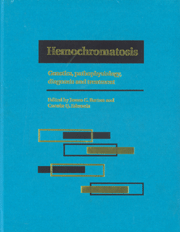Book contents
- Frontmatter
- Contents
- List of contributors
- Foreword
- Part I Introduction to hemochromatosis
- Part II Genetics of hemochromatosis
- Part III Metal absorption and metabolism in hemochromatosis
- Part IV Diagnostic techniques for iron overload
- Part V Complications of iron overload
- 21 Mechanisms of iron toxicity
- 22 Iron as a carcinogen
- 23 Clinical spectrum of hepatic disease in hemochromatosis
- 24 The arthropathy of hemochromatosis
- 25 Diabetes mellitus and hemochromatosis
- 26 Non-diabetic endocrinopathy in hemochromatosis
- 27 Cutaneous manifestations of hemochromatosis
- 28 Cardiac abnormalities in hemochromatosis
- 29 Estimate of the frequency of morbid complications of hemochromatosis
- 30 Juvenile hemochromatosis
- Part VI Therapy of hemochromatosis and iron overload
- Part VII Infections and immunity in hemochromatosis
- Part VIII Hemochromatosis heterozygotes
- Part IX Relationship of hemochromatosis to other disorders
- Part X Animal models of hemochromatosis and iron overload
- Part XI Screening for hemochromatosis
- Part XII Hemochromatosis: societal and ethical issues
- Part XIII Final issues
- Index
21 - Mechanisms of iron toxicity
from Part V - Complications of iron overload
Published online by Cambridge University Press: 05 August 2011
- Frontmatter
- Contents
- List of contributors
- Foreword
- Part I Introduction to hemochromatosis
- Part II Genetics of hemochromatosis
- Part III Metal absorption and metabolism in hemochromatosis
- Part IV Diagnostic techniques for iron overload
- Part V Complications of iron overload
- 21 Mechanisms of iron toxicity
- 22 Iron as a carcinogen
- 23 Clinical spectrum of hepatic disease in hemochromatosis
- 24 The arthropathy of hemochromatosis
- 25 Diabetes mellitus and hemochromatosis
- 26 Non-diabetic endocrinopathy in hemochromatosis
- 27 Cutaneous manifestations of hemochromatosis
- 28 Cardiac abnormalities in hemochromatosis
- 29 Estimate of the frequency of morbid complications of hemochromatosis
- 30 Juvenile hemochromatosis
- Part VI Therapy of hemochromatosis and iron overload
- Part VII Infections and immunity in hemochromatosis
- Part VIII Hemochromatosis heterozygotes
- Part IX Relationship of hemochromatosis to other disorders
- Part X Animal models of hemochromatosis and iron overload
- Part XI Screening for hemochromatosis
- Part XII Hemochromatosis: societal and ethical issues
- Part XIII Final issues
- Index
Summary
Introduction
Approximately 1 in 250 individuals of northern European descent have hemochromatosis, making it one of the most common inherited disorders. In hemochromatosis, there is a pathologic expansion of body iron stores due to an increase in the absorption of dietary iron. Cellular uptake of circulating excess iron results in increased formation of ferritin and hemosiderin, especially in the parenchymal cells of several organs (e.g., liver, heart, pancreas). At high tissue iron levels, these organs show evidence of cellular damage accompanied by functional insufficiency. Although best studied in the liver, pathological studies also support the association of iron overload and tissue injury in other organs. The liver is a major site of excess iron accumulation, and massive deposition of iron within hepatocytes can lead to the development of fibrosis and cirrhosis. Excess iron can be stored as ferritin in both the cytoplasm and lysosomes, or as hemosiderin in lysosomes. The hepatic concentration of iron is an important factor in determining hepatotoxicity, because removal of excess iron by phlebotomy or chelation results in clinical improvement.
This chapter will describe the mechanisms of toxicity induced by iron overload, focusing on two major hypotheses: the oxidative injury hypothesis and the lysosomal injury hypothesis. These hypotheses concerning ironinduced damage are not mutually exclusive, because there is evidence of oxidative damage to lysosomal lipids that may contribute to lysosomal injury in iron overload. Evidence of damage to cellular organelles and to DNA after iron overload will also be summarized. There are several recent reviews of various aspects of iron-induced toxicity.
- Type
- Chapter
- Information
- HemochromatosisGenetics, Pathophysiology, Diagnosis and Treatment, pp. 229 - 238Publisher: Cambridge University PressPrint publication year: 2000
- 5
- Cited by



